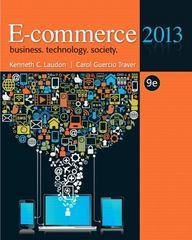Question
Julie Rowe graduated from high school five years ago with a background in agronomy. Julie had worked for a lawn care company until a year
Julie Rowe graduated from high school five years ago with a background in agronomy. Julie had worked for a lawn care company until a year ago, when she decided to start her own business selling soil testing kits. Julie had saved $10,000 during the past five years. She decided to invest $10,000 in a proprietorship to sell the soil testing kits in the local community.
Julie spent $4,750 for gas and other supplies and calculated she needed at least $1,000 to make ends meet before she received the first check. She also spent $19,250 to purchase kits that would be placed in inventory. Julie's sister agreed to keep the books. Julie's father let her use the family garage for an office and agreed not to charge rent the first year.
Julie purchased the following items to start the business. She purchased a service truck that cost $40,000, which she estimates will last another five years. Second, she purchased her own storage tank for gasoline to be used for the truck, and that cost $1,000. Third, she purchased a computer and some other office equipment for a total of $4,000.
Julie's father is willing to lend her $10,000. The principal is to be repaid in 18 months. The interest rate is 6 percent per year. At the end of 12 months, Julie will repay her father the interest for 12 months, but no principal. At the end of 18 months, Julie will pay her father interest for six months, plus the principal owed on the loan. Julie borrowed the balance of what she needed from the First National Bank. The loan will be repaid in five equal, annual principal payments, with interest at an annual rate of 7 percent.
At the end of the first year, Julie's expenses were as follows: gas, oil, repairs, and tires $7,900; telephone $600. During her first year, she purchased 1,000 kits at $35.00/kit that was in addition to the $19,250 spent on kits to start the business. The freight on the kits was $2,000. At the end of the first year of the business, she had $19,250 in inventory.
Her gross sales from the business were $87,000. Kits sold that had been returned for a refund had been sold for $200.00. She had been making $45,500 per year when working at her previous job, and she calculated that she should make at least that much to justify the time spent in the business. Her sister spent about one day a week doing the office work, and Julie felt that she should be reimbursed at a rate of at least $50 a day for her efforts. Her sister worked 50 weeks and went on vacation for two weeks.
1. Make a balance sheet as of the first day of business for Julie. The balance sheet is to be prepared after she purchased the assets needed to start the business and borrowed the money from her father and the bank. The date for the balance sheet is 12/31/2010. How much did she have to borrow from the bank?
2. Make a income statement for Julie's first year of business. Make the following assumptions:
- Depreciate all fixed assets over five years and assume a salvage value of $0.
- Julie makes her payment to the bank. She also pays her father interest only on the
- loan from him. She makes both payments on 12/31/2011.
- Assume Julie does not pay Social Security tax on her sister's salary and that she does
- not pay any state and federal income taxes.
3. Make a balance sheet for the end of the first year for Julie's business. Use the information provided on Julie Rowe's beginning balance sheet and income statement to finish ending balance sheet for Julie Rowe. The ending balance sheet date is 12/31/2011. Note: You will have to calculate Julie's cash balance on 12/31/2011 because it is not $1,000. Make the following assumptions:
- The ending inventory is the same amount as her beginning inventory, $19,250.
- The ending inventory for Julie's supplies is the same as the beginning balance sheet,
- $4,750.
- Julie lives with her parents so that reduces her need for living expenses. So she
- decided to withdraw $25,000 for family living expenses because she is living at home with her parents.
Step by Step Solution
There are 3 Steps involved in it
Step: 1

Get Instant Access to Expert-Tailored Solutions
See step-by-step solutions with expert insights and AI powered tools for academic success
Step: 2

Step: 3

Ace Your Homework with AI
Get the answers you need in no time with our AI-driven, step-by-step assistance
Get Started


